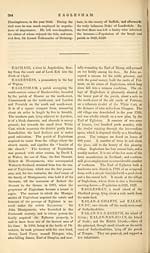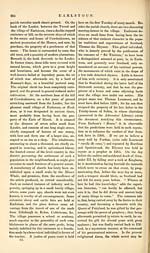Gazetteer of Scotland > Volume 1
(297) Page 265 - EAL
Download files
Complete book:
Individual page:
Thumbnail gallery: Grid view | List view

EARLSFERRY.
265
EALAN-USNICH, an islet in Loch
Etive, in the district of Lorn, Argyleshire.
EALLANGHEIRRIG,an island of small
dimensions, in the mouth of Loch Ridan, be-
tween Bute and Cowal. It derives some no-
toriety from having been fortified by the Earl
of Argyle, in 1685, in prosecution of his at-
tempt to establish the authority of the Duke
of Monmouth. The strong garrison of Eal-
langheirrig surrendered to the royalists, after
his Lordship's defeat.
EARLSFERRY, a town on the coast of
Fife, in the parish of Kilconquhar, lying at the
head of a fine sandy bay, and so intimately
joined with Elie on the east, that they both
appear as one town. Earlsferry is a town
almost unknown in Scotland, yet it has the
distinction of being a royal burgh, and is
governed by three bailies, fifteen councillors,
and a treasurer ; the oldest magistrate acting
as provost. The burgh lost its right of voting
for a member of parliament through inability
to pay for the support of a commissioner to the
Estates, prior to the Union. This has been
subsequently found to be a serious loss to
Earlsferry, which, not coming into notice in
cases of election, like other towns in Fife, and
being out of the way of ordinary traffic, has
been consigned to a most inglorious neglect.
It consists of a single street, with bye lanes,
and is supported chiefly by weaving and fish-
ing. It has no harbour. In the midst of its
houses, rises an ancient steeple, slated on the
sides, with dial-plates, the picture of impo-
tent old age. Yet, however dejected, impo-
verished, and depressed the ancient burgh town
of Earlsferry may now be, it was once a place
of some consequence, with certain valuable
privileges. It is perhaps not very generally
known that it had the immunity of giving re-
fuge to persons fleeing from the pursuit of jus-
tice. The tradition preserved illustrative of
the origin and extent of the privilege is as fol-
lows. When Macduff, the thane of Fife, fled
before the vengefid fury of Macbeth, and took
the route to England, he arrived in a panic at
the little fishing- village, the subject of our
notice, whither his pursuers followed in search
of him. By the assistance of the good
people of the place, he carefully concealed
himself in one of the caves, with which the
rocky shore is indented, a little to the west,
and so well was he sheltered that the officers
of Macbeth found it impossible to discover his
retreat. They, however, forbade any one to
provide him with the means of leaving the
coast, and kept a watchful eye on the whole
southern shore of Fife. Regardless of danger,
the fishermen of the town, watching an opportu-
nity, brought the fugitive Earl out of his cave,
and ferried him over to the opposite side, a
distance of at least ten miles.* For this great
service, the thane, on his restoration under
Malcolm III. or Canmore, procured from the
king certain burgal privileges for the town,
which was henceforth called Earlsferry, besides
the very singular immunity, that the persons
of all who should pass the Firth in a vessel
belonging to any of the inhabitants should be
inviolable, in the case of pursuit, till they were
half seas over. As this privilege could be
operated upon, whether in the case of felony
or simple debt, it may well be conjectured that
the place thenceforward became a resort to all
those who were obnoxious to seizure by the
hand of legal justice or private revenge. For
several ages it derived no small notoriety and
opulence from this circumstance, and it was
only in the sixteenth century, that the privilege
was withdrawn or fell into disuse. The last
authenticated case of a refugee coming hither
for protection was that of Carnegie of Fin-
haven, who had slain Lord Strathmore, in a
squabble in the street of Forfar, in 1728. The
cave in which Macduff was sheltered is still
shown, to the west of the town. It pene-
trates two hundred feet into the rock, and is
supposed to be a hundred and sixty feet high,
forming a grand alcove at the entrance from
the sea.
EARLSTOUN, (properly Ercildoun,) a
parish in the district of Lauderdale, Berwick-
shire, lying on the east bank of the Leader,
bounded on the south by Mertoun and on the
north by Legerwood. The river Eden rises
in its bounds, and flows towards the east. I15
length it is six miles, and its breadth from
three to four. Adjacent to the Leader and
the Eden, it is flat and arable. The other
parts lie high, and are partly pastoral and part-
ly arable. Plantations are now thriving. This
* It is a historical fact, so far as good Andrew Wintoun
can make it so, that Earlsferry was really the place of
Macduff's embarkation for Lothian, Kilconquhar Castle
being that in which his wife and children suffered from
the cruelty of the tyrant.
2 M
265
EALAN-USNICH, an islet in Loch
Etive, in the district of Lorn, Argyleshire.
EALLANGHEIRRIG,an island of small
dimensions, in the mouth of Loch Ridan, be-
tween Bute and Cowal. It derives some no-
toriety from having been fortified by the Earl
of Argyle, in 1685, in prosecution of his at-
tempt to establish the authority of the Duke
of Monmouth. The strong garrison of Eal-
langheirrig surrendered to the royalists, after
his Lordship's defeat.
EARLSFERRY, a town on the coast of
Fife, in the parish of Kilconquhar, lying at the
head of a fine sandy bay, and so intimately
joined with Elie on the east, that they both
appear as one town. Earlsferry is a town
almost unknown in Scotland, yet it has the
distinction of being a royal burgh, and is
governed by three bailies, fifteen councillors,
and a treasurer ; the oldest magistrate acting
as provost. The burgh lost its right of voting
for a member of parliament through inability
to pay for the support of a commissioner to the
Estates, prior to the Union. This has been
subsequently found to be a serious loss to
Earlsferry, which, not coming into notice in
cases of election, like other towns in Fife, and
being out of the way of ordinary traffic, has
been consigned to a most inglorious neglect.
It consists of a single street, with bye lanes,
and is supported chiefly by weaving and fish-
ing. It has no harbour. In the midst of its
houses, rises an ancient steeple, slated on the
sides, with dial-plates, the picture of impo-
tent old age. Yet, however dejected, impo-
verished, and depressed the ancient burgh town
of Earlsferry may now be, it was once a place
of some consequence, with certain valuable
privileges. It is perhaps not very generally
known that it had the immunity of giving re-
fuge to persons fleeing from the pursuit of jus-
tice. The tradition preserved illustrative of
the origin and extent of the privilege is as fol-
lows. When Macduff, the thane of Fife, fled
before the vengefid fury of Macbeth, and took
the route to England, he arrived in a panic at
the little fishing- village, the subject of our
notice, whither his pursuers followed in search
of him. By the assistance of the good
people of the place, he carefully concealed
himself in one of the caves, with which the
rocky shore is indented, a little to the west,
and so well was he sheltered that the officers
of Macbeth found it impossible to discover his
retreat. They, however, forbade any one to
provide him with the means of leaving the
coast, and kept a watchful eye on the whole
southern shore of Fife. Regardless of danger,
the fishermen of the town, watching an opportu-
nity, brought the fugitive Earl out of his cave,
and ferried him over to the opposite side, a
distance of at least ten miles.* For this great
service, the thane, on his restoration under
Malcolm III. or Canmore, procured from the
king certain burgal privileges for the town,
which was henceforth called Earlsferry, besides
the very singular immunity, that the persons
of all who should pass the Firth in a vessel
belonging to any of the inhabitants should be
inviolable, in the case of pursuit, till they were
half seas over. As this privilege could be
operated upon, whether in the case of felony
or simple debt, it may well be conjectured that
the place thenceforward became a resort to all
those who were obnoxious to seizure by the
hand of legal justice or private revenge. For
several ages it derived no small notoriety and
opulence from this circumstance, and it was
only in the sixteenth century, that the privilege
was withdrawn or fell into disuse. The last
authenticated case of a refugee coming hither
for protection was that of Carnegie of Fin-
haven, who had slain Lord Strathmore, in a
squabble in the street of Forfar, in 1728. The
cave in which Macduff was sheltered is still
shown, to the west of the town. It pene-
trates two hundred feet into the rock, and is
supposed to be a hundred and sixty feet high,
forming a grand alcove at the entrance from
the sea.
EARLSTOUN, (properly Ercildoun,) a
parish in the district of Lauderdale, Berwick-
shire, lying on the east bank of the Leader,
bounded on the south by Mertoun and on the
north by Legerwood. The river Eden rises
in its bounds, and flows towards the east. I15
length it is six miles, and its breadth from
three to four. Adjacent to the Leader and
the Eden, it is flat and arable. The other
parts lie high, and are partly pastoral and part-
ly arable. Plantations are now thriving. This
* It is a historical fact, so far as good Andrew Wintoun
can make it so, that Earlsferry was really the place of
Macduff's embarkation for Lothian, Kilconquhar Castle
being that in which his wife and children suffered from
the cruelty of the tyrant.
2 M
Set display mode to: Large image | Transcription
Images and transcriptions on this page, including medium image downloads, may be used under the Creative Commons Attribution 4.0 International Licence unless otherwise stated. ![]()
| Gazetteers of Scotland, 1803-1901 > Gazetteer of Scotland > Volume 1 > (297) Page 265 - EAL |
|---|
| Permanent URL | https://digital.nls.uk/97427926 |
|---|
| Description | Volume I: Abbey to Glenartney. |
|---|---|
| Attribution and copyright: |
|
| Description | By Robert Chambers and William Chambers. Glasgow: Blackie & Son, 1838. 2 volumes. |
|---|---|
| Shelfmark | NF.1461.g.7 |
| Additional NLS resources: | |

